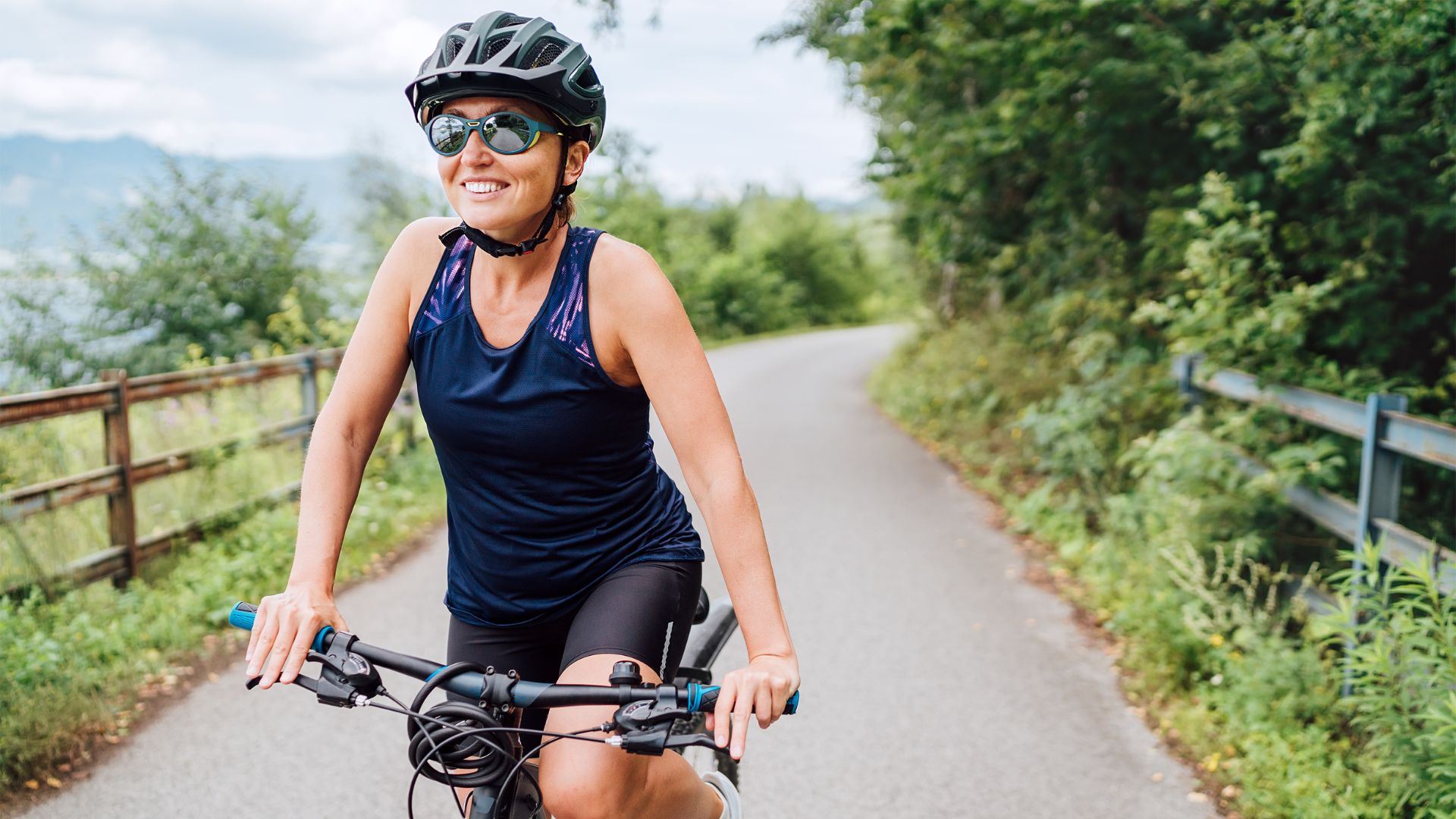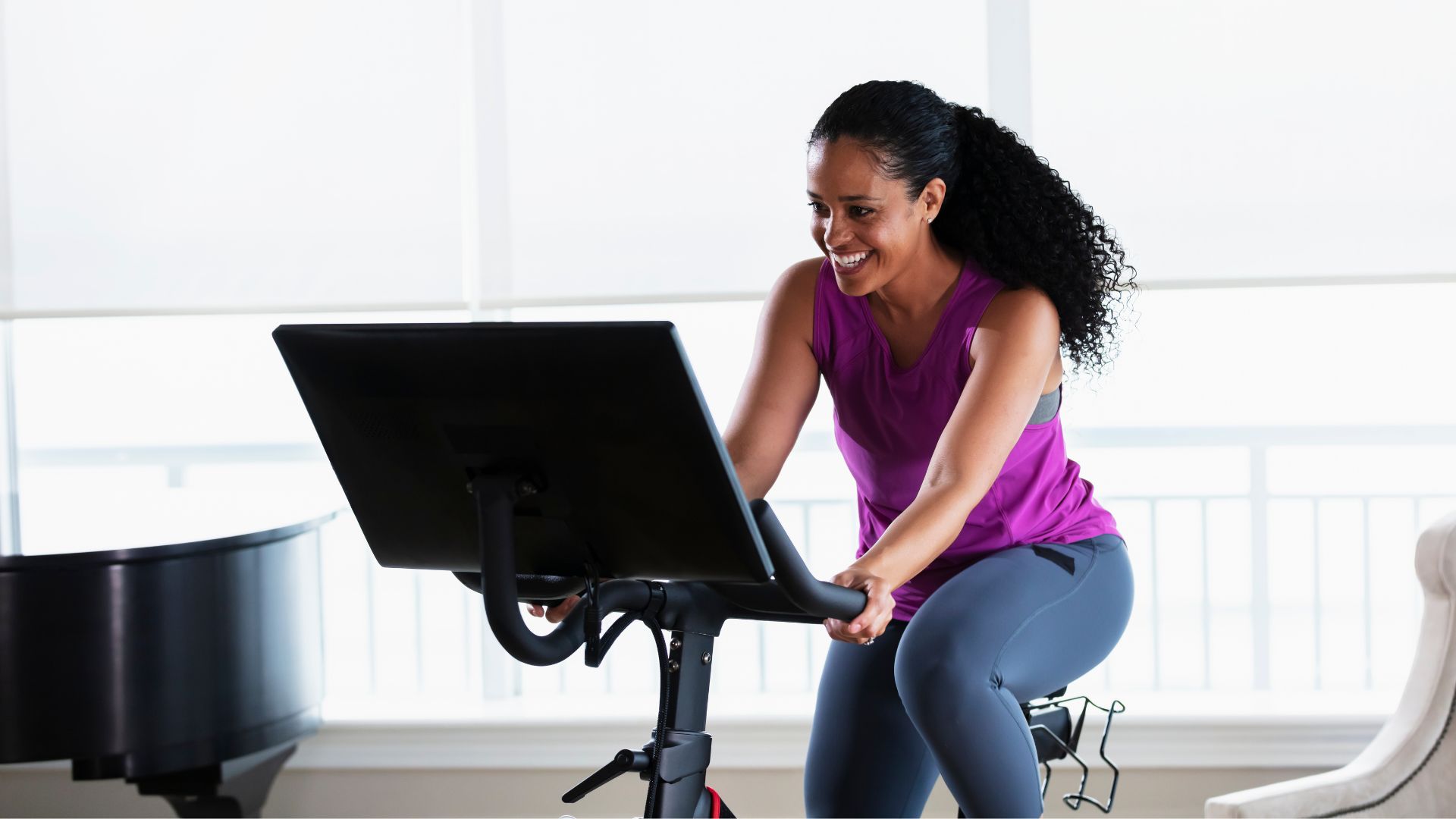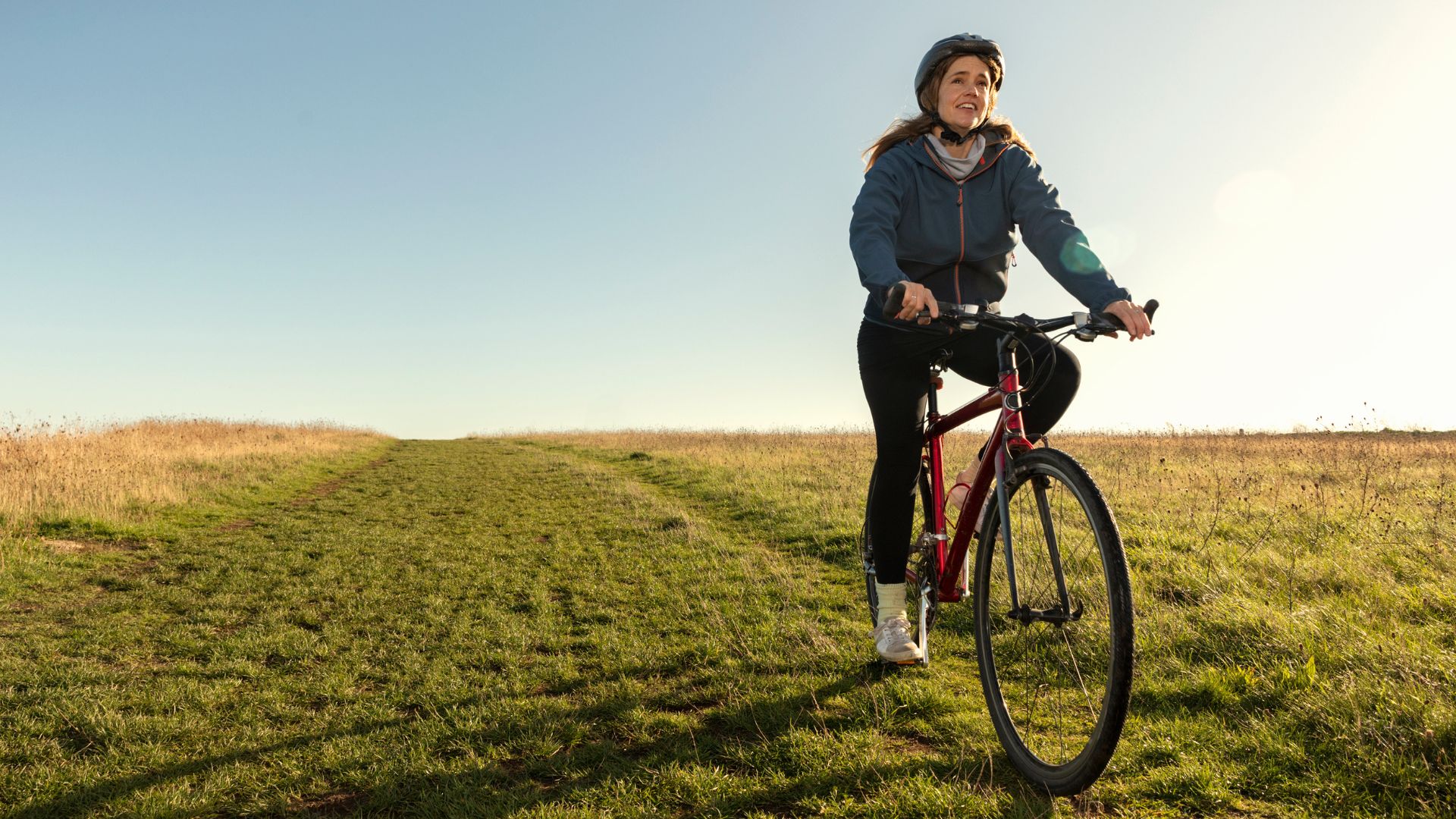Cycling workouts are the low-impact way to boost full-body fitness - 4 to try outdoors or in the gym
Cycling as a workout is an underrated way to boost strength, cardiovascular fitness, stability, and core strength


Cycling as a workout is also an ideal alternative to higher-impact activities like walking and running for beginners, with pushing down on the pedals being easier on the bones and joints than pounding the pavement.
There's no denying that there's a little more involved in cycling than running or even swimming (from the bike itself to cycling apps to help map your route), but we know the benefits are worth the effort.
"Compared to running or even walking, cycling gives support while still allowing you to be weight-bearing," says personal trainer Alanah Bray. "This also means that it’s kind on the body and it’s low-impact on joints, which makes it a repeatable exercise as the body doesn’t need time to recover. You can also improve your aerobic endurance as well as burn calories through cycling."
What's not to love? Whether you cycle every day or want to bring the sport into your life as a beginner, we have you covered with advice from a Les Mills cycling coach, a personal trainer, former Olympian, and strength specialist on the cycling workouts to try.
Why is cycling as a workout so good for beginners?
Cycling's low-impact nature and accessibility make it a perfect workout for beginners and anyone returning to exercise after a few years off. Whether you prefer to make the time to cycle outdoors or slot in a quick spinning workout at the gym, you can reap the benefits.
A study published in the Nature Journal shows it's also a winner for older adults, with researchers finding the sport was "particularly effective" in improving functional abilities like walking speed and balance.
Cycling workouts to try
1. Power intervals
For beginners, silver medalist Olympian cyclist Dotsie Bausch recommends doing some kind of interval training regularly to improve cardiovascular fitness. "I love power intervals as they don't take very long but are effective for generating fat loss and cardiovascular training," she says.
Sign up to our free daily email for the latest royal and entertainment news, interesting opinion, expert advice on styling and beauty trends, and no-nonsense guides to the health and wellness questions you want answered.
Here's the workout she recommends:
- Warm-up: Pedal for at least 15 minutes, steadily building pressure on the pedals.
- Intervals:
- 2 minutes - hard effort
- 2 minutes - easy pedalling
- Repeat 8 times
- Cool down: For 5 minutes at the end of your workout, slow your pace right down to a speed that feels comfortable but where you're still moving your legs. Don't stop completely.
Expert tip: "If you're a beginner, you can start with 5 or 6 intervals and build up to 8," says Bausch. "It's a really fun (and hard) workout and but if you have a heart rate monitor or a bike with a power meter, you can try and beat yourself each time you do it." You can also use one of the best fitness trackers to do this.
2. Pyramid intervals
Pyramid intervals involve increasing and decreasing the intensity and duration of efforts while doing cycling as a workout. If you were to measure your heart rate or speed on a graph, it would (hopefully) look like a pyramid shape, hence the name.
Here, Butler-Clack shares her favourite way to do this workout:
- Warm-up: After some mobility stretches, pedal for 15 minutes, building up speed and pressure as you progress towards the start of the workout.
- Main session (going up the pyramid):
- 1 minute of moderate to high-intensity cycling, followed by 1 minute of cycling at a low intensity.
- 2 minutes of moderate to high-intensity cycling, followed by 1 minute of low-intensity cycling.
- 3 minutes at a moderate to high intensity, followed by 3 minutes recovery at a low intensity
- Main session (coming down the pyramid):
- 2 minutes at a moderate to high intensity, followed by 2 minutes of recovery at a low intensity
- 1 minute at a moderate to high intensity, followed by a 1-minute recovery cycling at a low intensity.
- Cool-down: "I would recommend 5-10 minutes, gradually reducing intensity from the main session to help the body gradually return to its normal state," says Butler-Clack, who works with online platform P3rform.
3. Hill repeats
Really looking to skyrocket your fitness? "If there are some hills in your area, you can try some hill intervals. This routine will send your heart rate sky high as you swap between sweated and standing positions on the incline," says fitness trainer and cycling specialist Gabriella Guevara.
If there are only one or two around you, you can cycling up the same one repeatedly, freewheeling on the way back down as a break.
Some indoor bikes - like a Wattbike Proton or Zwift set-up - will have programs to help you do this cycling workout, automatically making the effort harder as if you were going up a real hill.
Expert tip: "For those new to the activity, investing in an e-bike might be best as it will give you an extra push and surge in confidence to make it to the top," says Guevara.
4. Endurance ride
If you're starting out as a beginner in cycling, you might prefer to try an endurance ride on your bike. These are a little more outdoor-friendly than some interval training sessions, which can be better down on an indoor bike where you don't have to worry about your surroundings so much.
Try this one:
- Warm-up: Pedal for 10 minutes to warm up your muscles, after completing some simple stretches and mobility exercises.
- Main session:
- 30 seconds of cycling at moderate to high intensity
- 30 seconds of cycling at a slower pace and lower intensity
- Complete the routine 20 times.
- Cool down: Finish with a 10-minute cool down at an easy pace.

Tips for doing cycling as a workout
1. Start steady
Before jumping on the bike, spend some time getting your muscles ready for exercise with a warm-up and stretches. This will make your ride a little easier as your body is prepared for the work.
"As a warm-up, I would start with a pulse raiser of 5 to 10 minutes of cycling at a moderate intensity, followed by a series of mobility exercises," says physical performance coach and strength specialist Elizabeth Butler-Clack.
Then, much like doing swimming as a workout, it's important to cycle at your own pace. If you're thinking about riding outdoors with friends, head out with just one person or solo to begin with and build up your fitness, so you don't feel pressured to keep up a pace you're uncomfortable with. If you're in the studio, don't feel pressured to move up a level if you're not ready yet.
2. Find a program that works for you
Once you're in the swing of things, finding a routine could help you stay motivated and keep progressing. Your workout could be as simple as cycling three times a week for 30 minutes or a rhythm-based spin class once a week. Whatever works best for you.
3. Cycle across different elevation
There are many benefits of indoor cycling, but variety isn't one of them. Getting outdoors on the bike will be a lot more interesting, and you'll get the added benefit of better hand-eye coordination through bike handling, too.
You'll also be able to cycle across varying elevations and terrains, which will naturally put you through a full-body workout and force you to work harder than you otherwise might do naturally in the gym.
4. Practice good technique
Much like with running, everyone thinks they can just jump on a ride and ride but that's not the case. "Practising good technique can help with riding efficiency and reduce the risk of injury," says Guevara.
Your back should be relaxed with your torso leaning forward slightly, with a relatively straight line held between your hips and shoulders.
Many bike shops also offer bike fittings, where a specialist will purposefully fit your bike (e.g. saddle and handlebar height) to your measurements.

5. Incorporate some strength training
As cycling is a sport with limited impact on your bones and joints, it's important to mix up your riding with strength training. Whether you do Pilates with weights or classic weightlifting, incorporating resistance training will help you develop your muscles to keep up with cycling, improve your form, and ward off muscle loss that's linked to menopause.
"If building strength is also one of your aims, it is important to include some strength training sessions in your training week," says Butler-Clark.
Plus, as cycling is mainly a lower-body workout, doing an upper-body workout will help you 'tone', i.e. build muscle, in your arms, back, shoulders, and chest.
6. Include some fun cycling workouts into your routine
Cycling for hours on end every week without spicing things up once in a while is bound to get boring and, as the research shows, we are much less likely to continue with an activity when it becomes dull.
For a fun indoor cycling workout, opt for a rhythm-based ride. If you cycle indoors, this will be your standard spinning class. “Rhythm-based rides hardly have any metrics. For inexperienced riders or beginners, this is really enticing because it isn't numerically competitive," explains Guevara, who is also the founder of The Cadence Club.
7. Consistency is key
Perhaps the most important tip the trainers have for those looking to do cycling as a workout is to keep it up. "When it comes to building aerobic fitness, consistency is key," says Butler-Clark.
"Try to ride regularly, even if it's just a low-intensity recovery ride. Over time, this will help build your aerobic fitness," she says.
8. Listen to your body
Try not to push yourself too hard in the beginning, says Butler-Clack. "Try to gradually increase your mileage over time, as this will help build a base of aerobic fitness and reduce the risk of injury. Little and often may be the best approach."
As well as this, contrary to popular belief, it's important to take time off from exercise. You'll achieve most of your progress on the days when you do no exercise at all, as your body has a chance to recover.
How long should cycling workouts be?
The duration of your cycling workout will reflect your fitness levels and goals, says Les Mills UK trainer and presenter Emma Macdonald. "The average time most people would do is 45 minutes for improving cardiovascular fitness, but someone short on time might want to ride for less than this," she says.
"The main focus is that you move safely while doing a workout that suits you and that you enjoy," she says.
The NHS recommends 150 minutes of moderate intensity exercise, which including cycling as a workout, every week. If you were to cycle for 30 minutes a day, five days a week, you'd reach this amount easily.
Is outdoor cycling better than indoor?
This one is entirely down to personal preference, says Macdonald, but there are a couple of factors to bear in mind:
- Cost: If you don't have a bike and helmet, you'll need to buy one to cycle outdoors. But if you have a gym membership or indoor bike at home, you'll be able to cycle at no extra cost.
- Weather conditions: Indoor cycling doesn't have the challenge of rain or wind, she says. Thanks to the danger of tyres slipping on the wet ground, many people choose running vs cycling in the colder and wetter months.
- Convenience: "Indoor cycling also eliminates time spent on route planning or traffic navigation," says Macdonald.
- Structure: Outdoor cycling has the benefit of fresh air and varied terrain, but indoor cycling is "ideal for structured workouts, heart rate zones, and tracking performance," says Macdonald.
- Socialising: Both indoor and outdoor cycling have huge communities, in person and online.

Grace Walsh is woman&home's Health Channel Editor, working across the areas of fitness, nutrition, sleep, mental health, relationships, and sex. She is also a qualified fitness instructor. In 2025, she will be taking on her third marathon in Brighton, completing her first ultra marathon, and qualifying as a certified personal trainer and nutrition coach.
A digital journalist with over seven years experience as a writer and editor for UK publications, Grace has covered (almost) everything in the world of health and wellbeing with bylines in Cosmopolitan, Red, The i Paper, GoodtoKnow, and more.